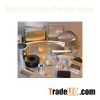General Information
A neodymium magnet (also known as NdFeB, NIB, or Neo magnet), the most widely used type of rare-earth magnet, is a permanent magnet made from an alloy of neodymium, iron, and boron to form the Nd2Fe14B tetragonal crystalline structure. Developed in 1982 by General Motors and Sumitomo Special metals, neodymium magnets are the strongest type of permanent magnet made. They have replaced other types of magnet in the many applications in modern products that require strong permanent magnets, such as motors in cordless tools, hard disk drives, and magnetic fasteners.
The tetragonal Nd2Fe14B crystal structure has exceptionally high uniaxial magnetocrystalline anisotropy (HA~7 teslas). This gives the compound the potential to have high coercivity (i.e., resistance to being demagnetized). The compound also has a high saturation magnetization (Js ~1.6 T or 16 kG) and typically 1.3 teslas. Therefore, as the maximum energy density is proportional to Js2, this magnetic phase has the potential for storing large amounts of magnetic energy (BHmax ~ 512 kJ/m3 or 64 MG·Oe), considerably more than samarium cobalt (SmCo) magnets, which were the first type of rare earth magnet to be commercialized. In practice, the magnetic properties of neodymium magnets depend on the alloy composition, microstructure, and manufacturing technique employed.
Sintered Nd2Fe14B tends to be vulnerable to corrosion. In particular, corrosion along grain boundaries may cause deterioration of a sintered magnet. This problem is addressed in many commercial products by adding a protective coating. Nickel plating or two-layered copper-nickel plating are the standard methods, although plating with other metals or polymer and lacquer protective coatings is also in use.
There are two principal neodymium magnet manufacturing routes:
The classical powder metallurgy or sintered magnet process
The rapid solidification or bonded magnet process
Sintered Nd-magnets are prepared by the raw materials being melted in a furnace, cast into a mold and cooled to form ingots. The ingots are pulverized and milled to tiny particles. This undergoes a process of liquid-phase sintering whereby the powder is magnetically aligned into dense blocks which are then heat-treated, cut to shape, surface treated and magnetized.
Sintered NdFeB







